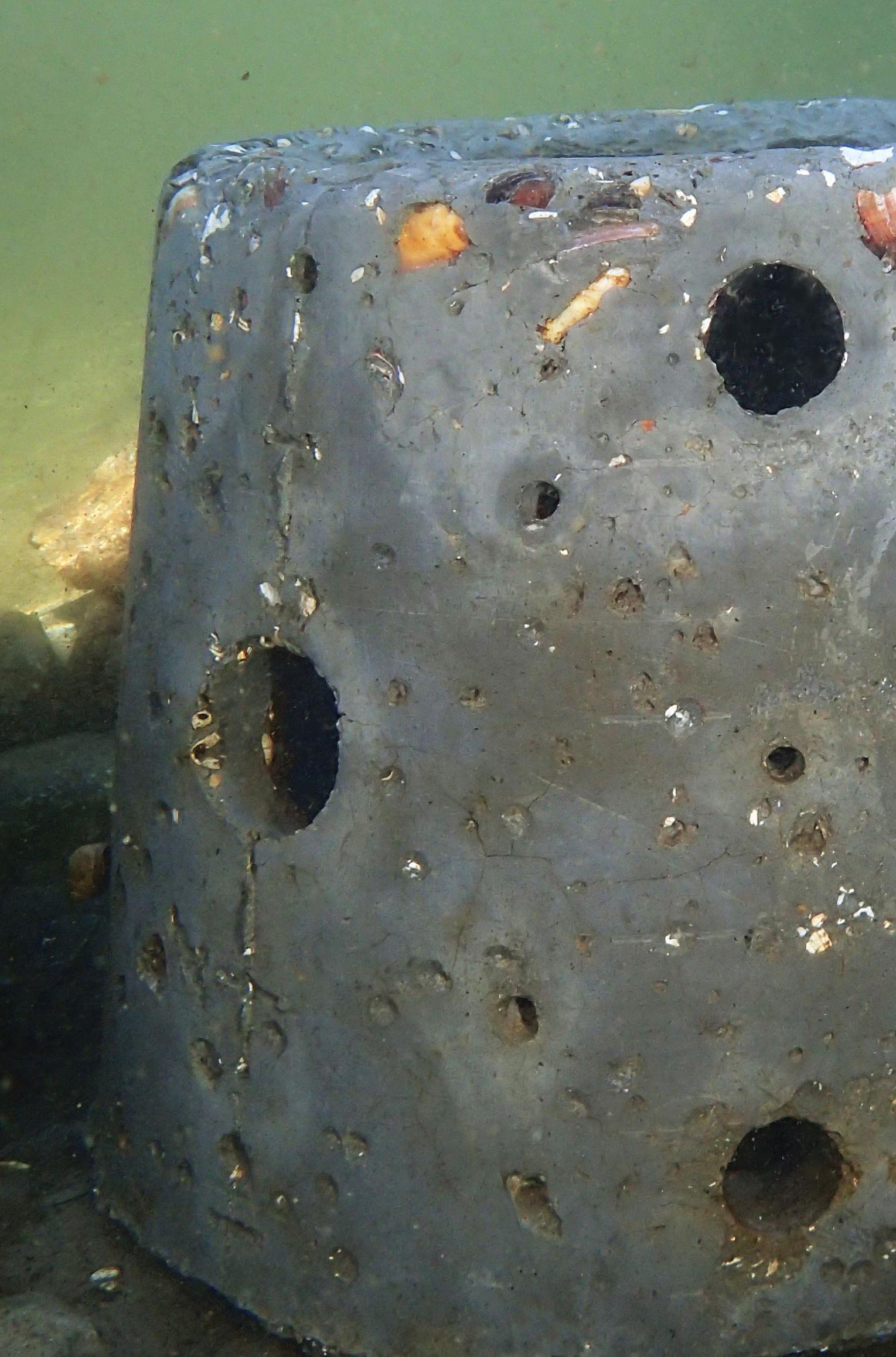
13 minute read
USING TRAPEZOID CONCRETE REEF ELEMENTS TO BUILD ARTIFICIAL REEFS
Trapezoid reef elements made of concrete can be designed to replicate natural reef features. The reef elements may host marine organisms similar to natural reefs and have the potential to benefit the marine environment.
Advertisement
Mesak Ramos Kekasih Msc, Nature Management, University of Copenhagen Tim Wilms Postdoctoral researcher, DTU Aqua Jon C. Svendsen Senior researcher, DTU Aqua Wolfgang Kunther Associate Professor, Technical University of Denmark, Department of Environmental and Resource Engineering Maria Heisterberg Hansen Msc Environmental Engineer, Technical University of Denmark
FROM DEGRADED NATURAL STONE REEFS TO ARTIFICIAL REEFS
Natural Danish stone reefs are degraded due to stone excavations that took place at least from the 1900’s until around 2000 and were finally banned by Danish law in 2010. The stone excavations depleted large areas of stone reefs and left many of them in an unstable state. Stone reefs play an important role as essential marine habitats, and therefore restoration of existing reefs, or establishment of new reefs, is needed to support a healthy marine environment. As part of a wider effort to conserve and restore marine habitats in Danish waters, stone reefs have been established or restored using natural boulders (Støttrup et al., 2017). Boulders create hard surfaces, ledges and cavities to increase structural complexity and shelter availability for marine organisms. The provision of boulders for the construction of reefs can be costly and often includes transportation from abroad (e.g. from Norway). As a supplement to boulders, artificial reef elements may be constructed locally using concrete, iron, or other hard materials. Concrete is the most used material for the construction of artificial reef elements worldwide and often promotes a high abundance of benthic organisms that settle in layers (Florisson et al., 2018; Baine, 2001). Concrete made with ordinary Portland cement exposed to seawater form a surface crust of calcium carbonates (as observed in Danish waters, Jacobsen et al., 2016). Calcium carbonates (CaCO3) have a chemical composition resembling mussel shells or the solid structure of corals. Therefore, the design and use of concrete reef elements for ecological benefits should be achievable, given proper evaluation of deployment sites and robust field-testing of the effects on biological communities. Concrete elements might then be considered as supplements in ongoing efforts to enhance Danish marine habitats and biodiversity. Concrete reefs are used to a great extent in e.g. USA, Australia and southern European countries with the purpose to enhance and protect biodiversity and fish abundance, as well as to manage fisheries and benefit recreational activities like snorkelling and SCUBA diving; thereby raising the public awareness of marine life (Schygulla, C., & Peine, 2013; Harris, 2009). Few detailed and long-term monitoring studies have been conducted on artificial reefs, however, in Australia, the deployment of concrete artificial reefs in estuaries with low amounts of natural rocky reefs

Figure 1: Conceptual figure of marine life possibly associated with the concrete trapezoid reef element. The open top ensures light penetration to the central cavity and is intended to reduce lifting effects of wave action during stormy weather. Further purposes of the designed artificial reef element are discussed in the next section.
EXAMPLES OF ARTIFICIAL CONCRETE REEFS AND OTHER CONCRETE ELEMENTS WITH HABITAT DEVELOPMENT IN DENMARK AND NEIGHBOURING COUNTRIES
2001 Project AWARE (Aquatic World Awareness Responsibility and Education Foundation) deployed 50 reef balls within brackish coastal waters in the Netherlands (Dietrich, 2002). Reef Balls are hollow, textured, porous concrete domes; used to mimic natural reef habitats.
2001 Reef Balls at the German coasts of Kiel and Nienhagen: Reef Balls were deployed by a private company for the purpose of biological development research (Fabi et al., 2011). 2003 Artificial concrete reef elements in a four hectares area at the Nienhagen coast of Germany: The area was enriched by habitat development on the hard substrate, enhancing the local abundance of cod (Schygulla & Peine, 2013; Fabi et al., 2011). 2005 The Nysted offshore wind farm in Denmark: The concrete windmill foundations hosted an abundance of blue mussels (Mytilus edulis) and promoted barnacle settlement (Boesen & Anderson, 2005). 2008 Swedish concrete elements on the west coast near Lysekil: Observations showed that the concrete elements included cavities for the settlement of edible crabs (Cancer pagurus) and enhancement of local fish populations (Cottidae, black Goby (Gobius niger) and cod (Gadus morhua) (Langhamer et al., 2009). 2013 Fish aggregation at windmill artificial concrete reefs in the Belgian part of the North Sea: Monitoring Atlantic cod (Gadus morhua) and pouting (Trisopterus luscus) at a concrete windmill foundation reef in the North Sea showed that densities of both species were highly enhanced at the hard substrate habitats compared to the sandy sediments (Reubens et al., 2013). 2015 Concrete pillars in Sweden: In Sweden, sessile organisms like hydroid Laomedea sp. and other tunicate species such as Ascidiella sp. and Corella parallelogramma became the primary community to settle on the concrete pillars (Chase, 2015). This suggests that concrete elements can provide a hard platform for sessile organisms, similar to boulder habitats.
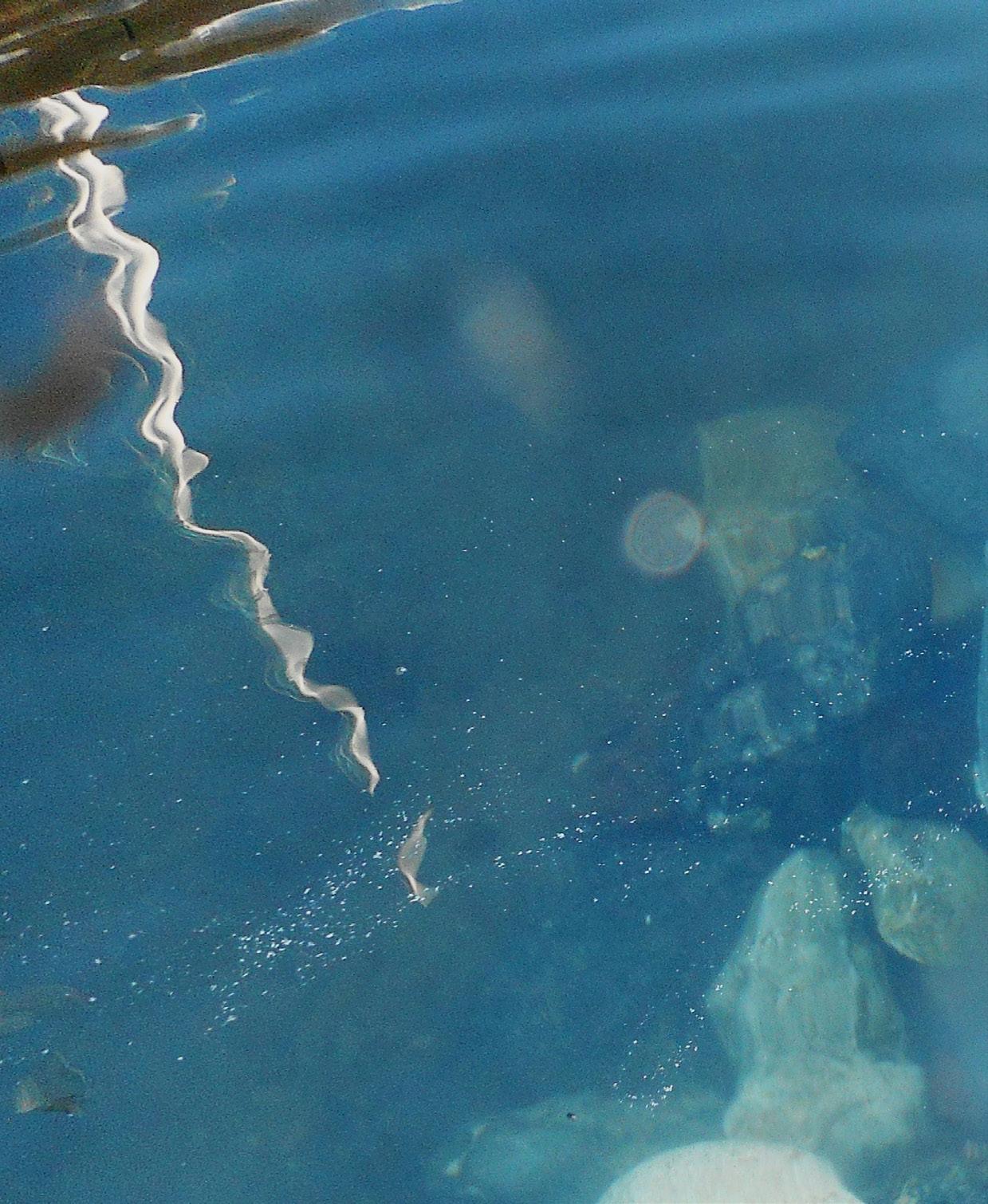
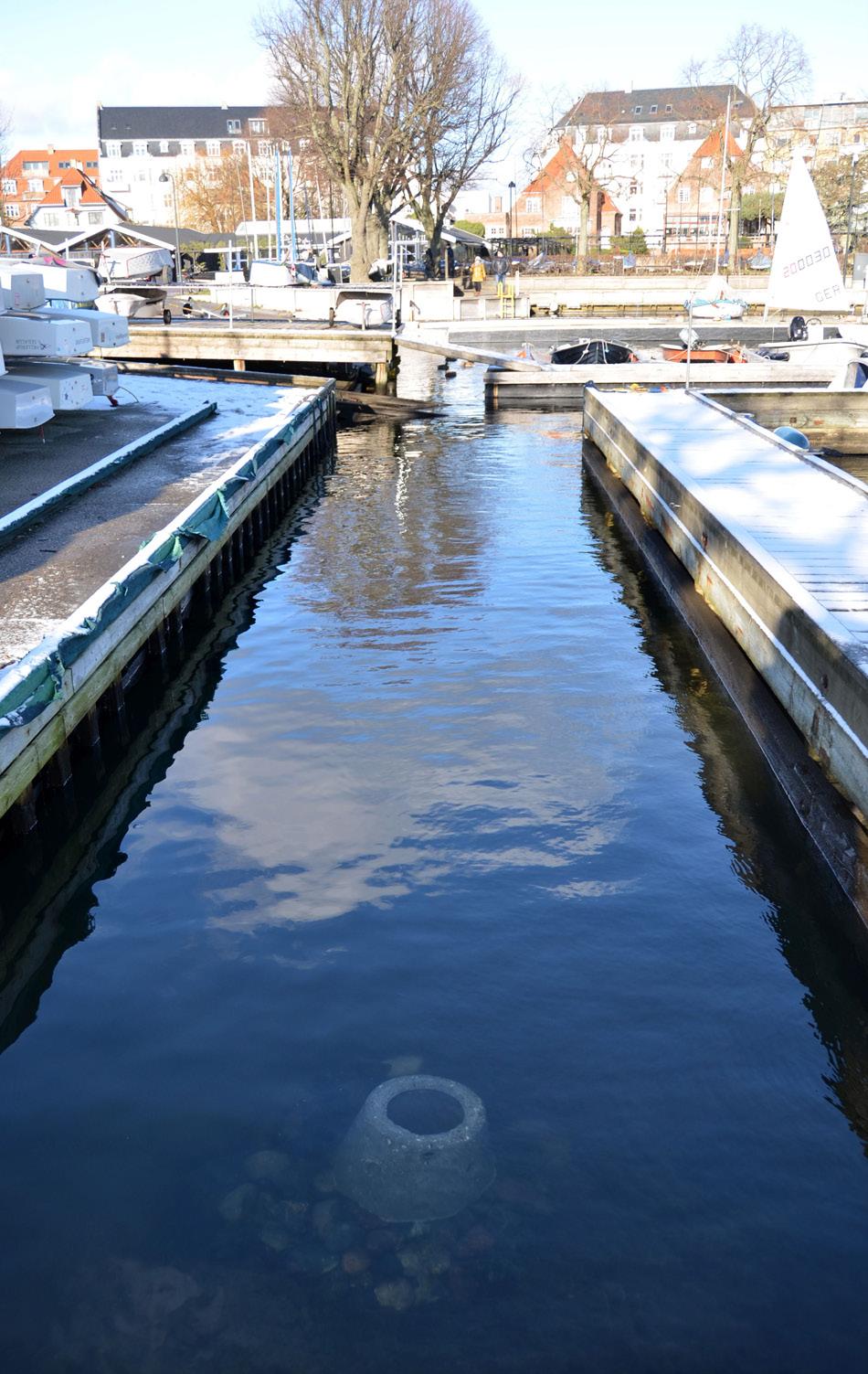
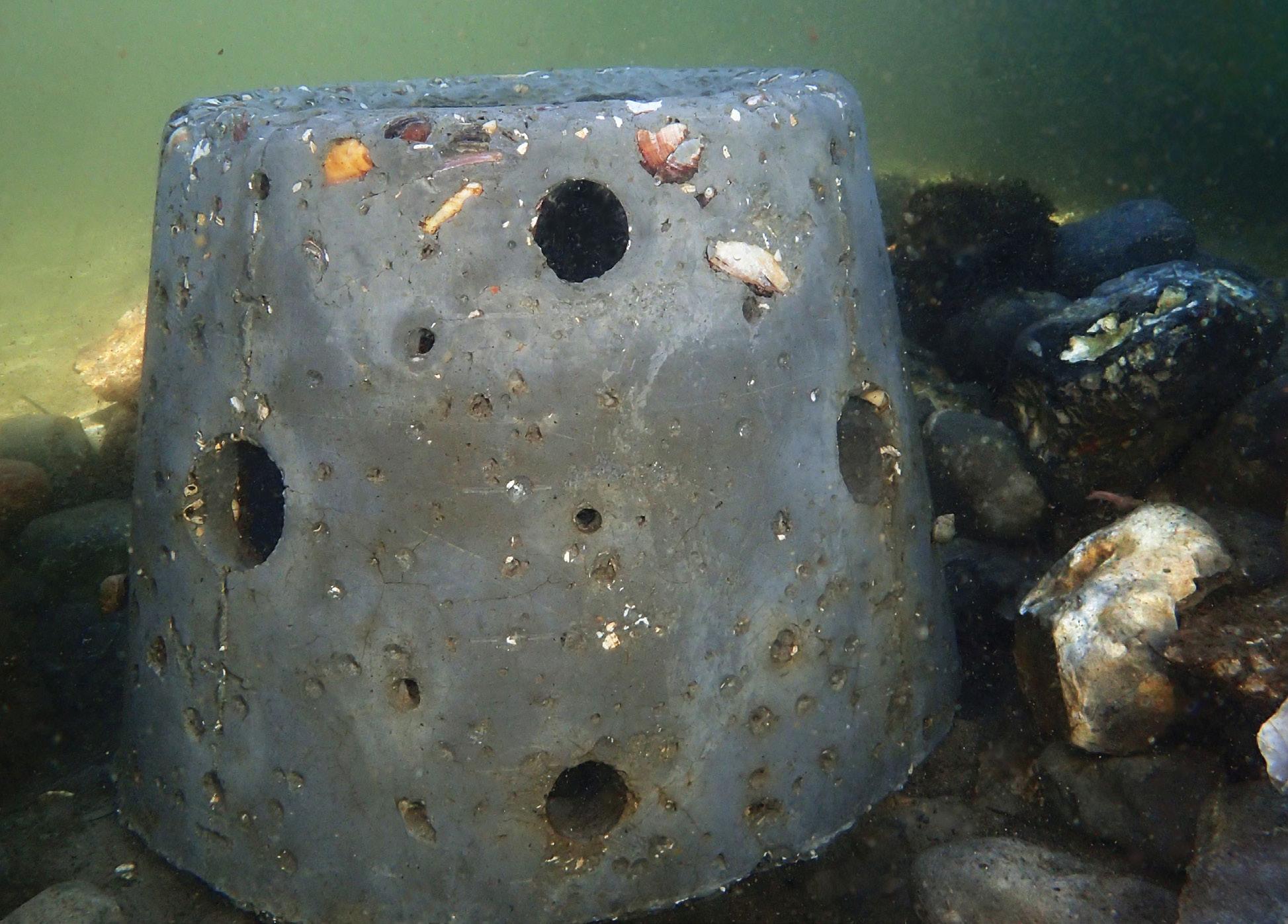
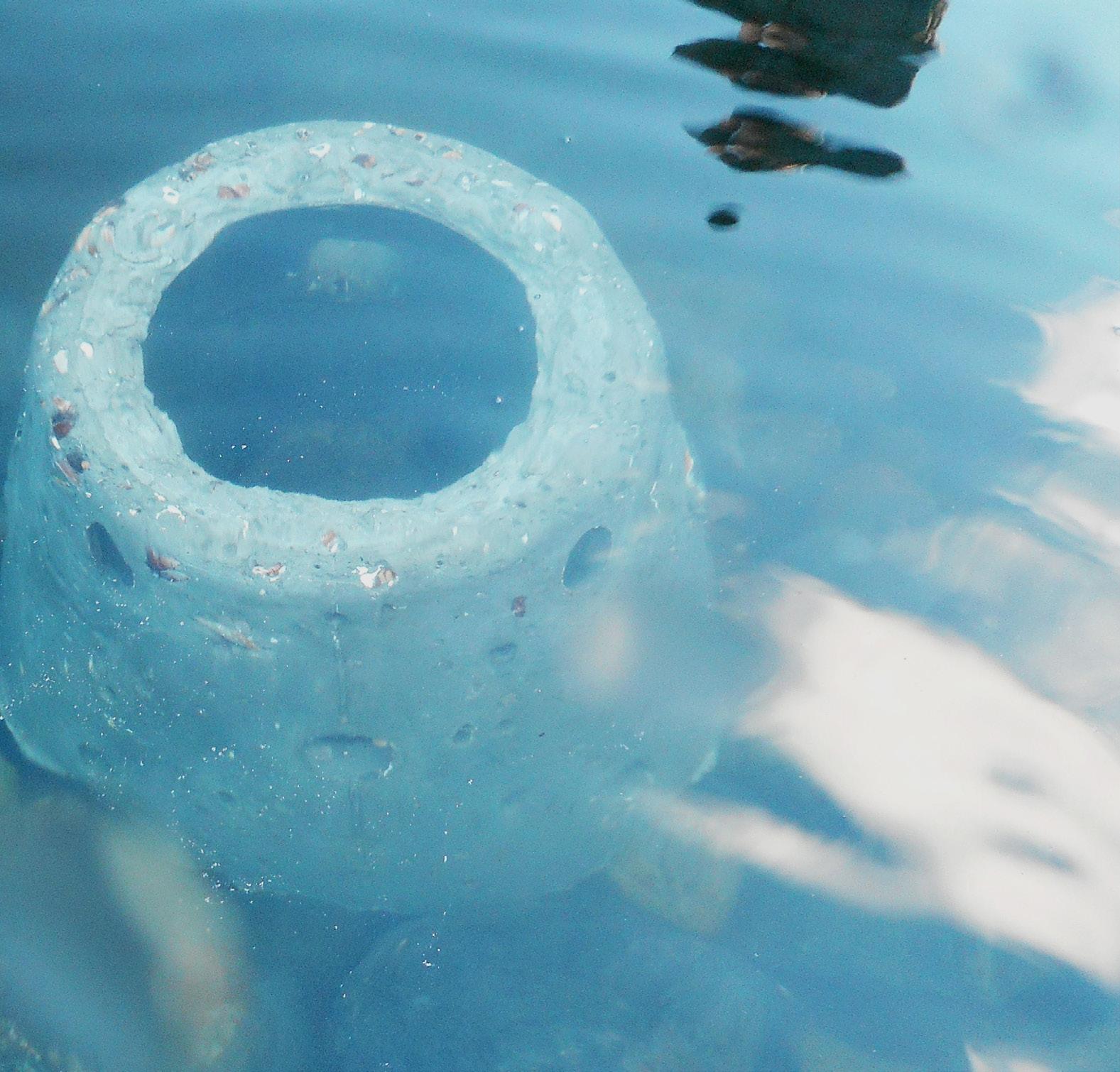
Figure 2: In the design phase of the artificial concrete reef element, different concrete recipes were tested in terms of hardness and stability. The reef body element is an eco-friendly artificial reef that contains biologically active compounds, an absence of toxic admixtures, and a rough surface texture which may host abundant and diverse benthic assemblages. The concrete mixture is designed with a reduced pH and intends to encourage biological life development. Thus far, a single copy of the designed artificial reef element has been produced which is deployed in shallow water within a harbour area in Øresund, Denmark. It has been deployed since 31st of January 2020.
seemed to increase the abundance of fish. Specifically, the fish abundance on the artificial reefs was comparable to, or higher, than the fish abundance on nearby natural rocky reefs (Folpp et al., 2020). Another study from Australia showed that, while artificial concrete reefs attracted different species compared with natural reefs, the concrete reefs continued to meet their pre-deployment goal of enhancing local recreational fisheries after a 10-year period (Becker et al., 2022).
SIMILARITIES BETWEEN ARTIFICIAL CONCRETE ELEMENTS AND NATURAL BOULDERS
Artificial reefs made from materials like concrete can be designed to replicate some features of natural reefs, such as roughness and structural complexity, and the type of shelter provision for marine organisms in the form of holes. This technique is already used in other European countries. Artificial concrete reefs are often scrutinised for potential negative impacts on the surrounding environment, as well as for the possibility of hosting different biological communities relative to natural reefs. The concrete material itself is unlikely to harm the natural marine environment (Florisson et al., 2018), while more future studies hopefully will give data on how artificial concrete reef elements develop over time. An artificial reef constructed from concrete may have similarities with natural stone reefs, as both types of reefs offer a hard substrate that provides a platform for colonisation of biogenic organisms e.g., blue mussels (Mytilus edulis). Unfortunately, there is a general lack of robust data on the species and abundance of fish, invertebrates and macroalgae (seaweed) that inhabit artificial reefs (Reis et al., 2021), but future projects from e.g. monitoring at offshore wind mill foundations might provide further insights. There is evidence that sessile organisms (e.g., sea anemones like Metri-
Concrete elements might then be considered as supplements in ongoing efforts to enhance Danish marine habitats and biodiversity. ”
dium senile and scallops like Aequipecten opercularis) can settle on concrete elements at a windmill farm in the southern North Sea (Kerckhof et al., 2010). One of the ecological functions of some sessile organisms called filter feeders is to improve the reef ecosystem's health by filtering particulate organic matter from the water column (Jagerroos & Krause, 2016). Another process that likely will occur is the development of macroalgal communities (Tsiamis et al., 2020) and the aggregation of mobile fauna such as crustaceans (edible crabs (Cancer pagurus) (Langhamer, 2012) and European lobster (Homarus gammarus)), fish and marine mammals (Coolen et al., 2020). Hard-bottom substrates and associated vegetation may also be important for the spawning of herring (Glarou et al., 2020), suggesting that artificial reefs could have similar functions.
DESIGNING ARTIFICIAL CONCRETE ELEMENTS – FEATURES AND POTENTIAL BENEFITS
A hollow trapezoid shaped reef element with varying number and diameter of holes fulfils many of the purposes of an artificial reef element. The designed reef element is supposed to be installed with cobble (stone) piles around the base of the element. These cobble piles serve as a natural foundation, protecting the reef unit against wave energy, while simultaneously functioning as a substrate for settlement of reef organisms. Potential benefits listed below are estimated from knowledge on concrete reefs in different shapes. Future testing of the designed reef trapezoid element should validate the proposed benefits.
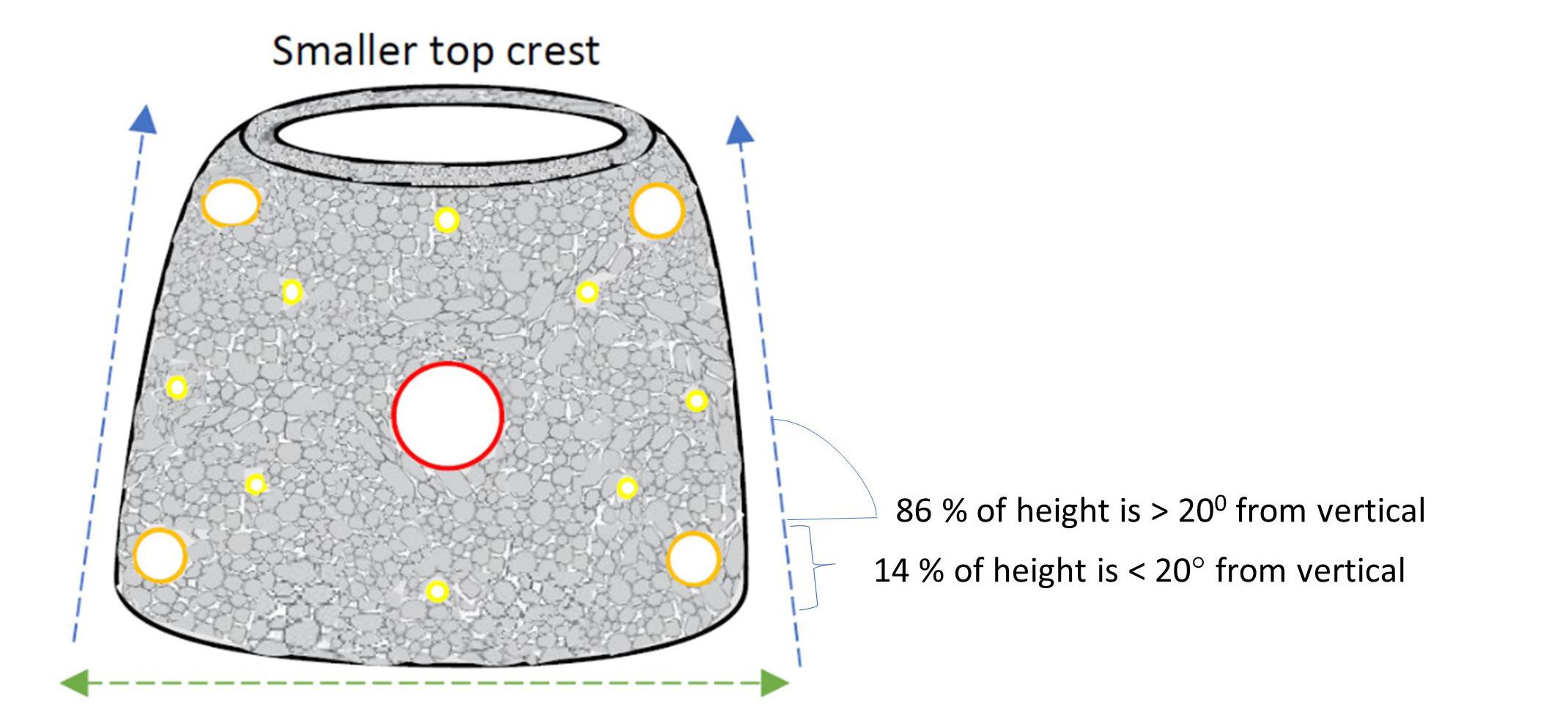
Figure 3: The designed artificial concrete reef element, with holes of varying diameters that serve as caves for marine life of varying size. Sizes: (big, 56 mm); marked with a red circle, medium (38 mm); marked with orange circles, and small (10 mm); marked with yellow circles. This element has a wider bottom (marked by green dashed line) which together with the narrower body element (see the marking of slopes with blue dashed lines) is intended to give stabilisation. The central cavity serves as a large cave for marine life and distributes the weight load across the surrounding lateral area which is intended to further increase stability.
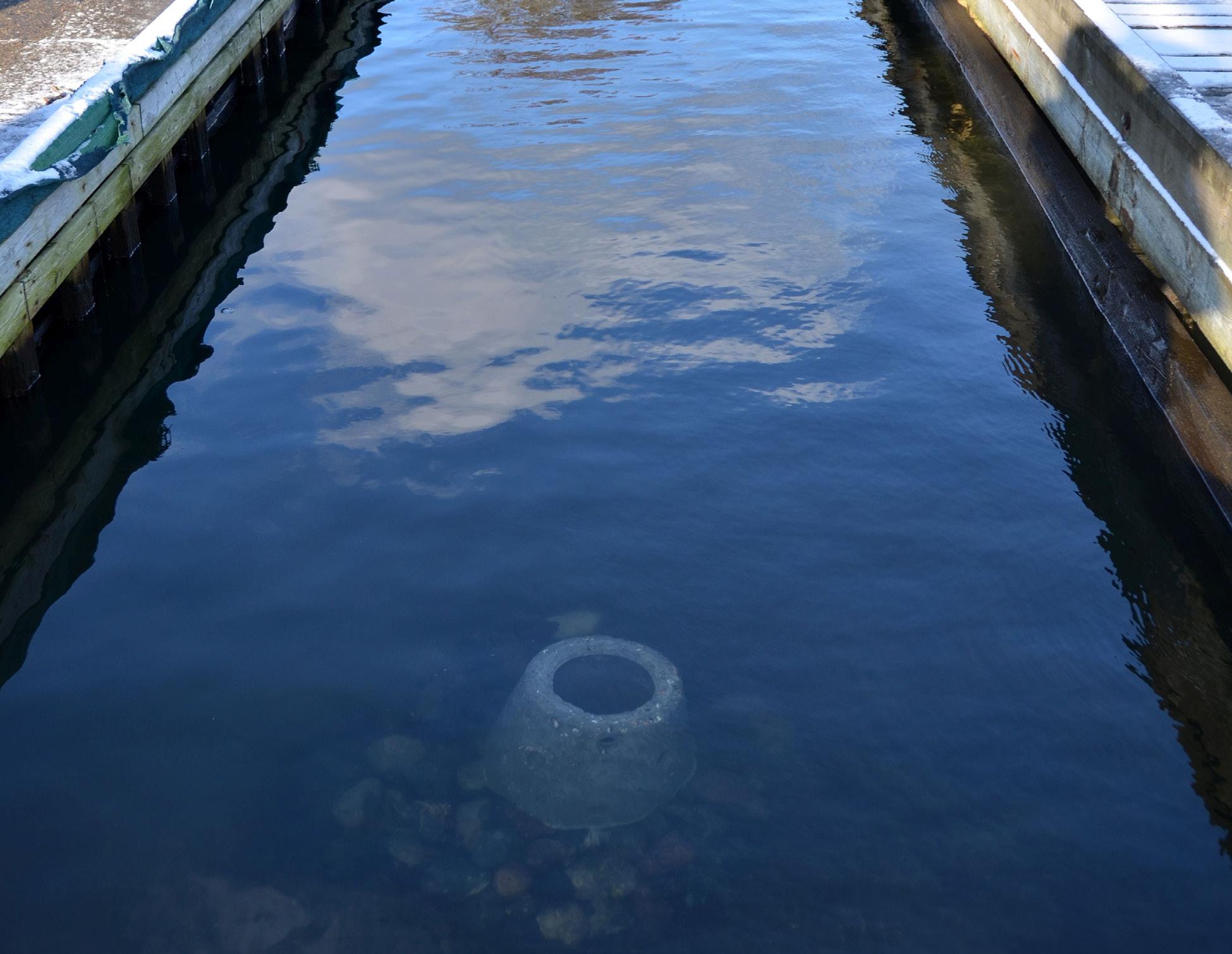
• A trapezoid shape may stabilise the reef element against wave action. • The reef element should be placed with the top of the reef element below winter ice to prevent ice related damage of the reef element.
• The formation with holes is designed to strengthen the reef element by dissipating the wave energy. • Vertical slopes in excess of 20° from the vertical are suitable for macroalgae colonisation (Linley et al., 2007). Additional potential advantages of nearly vertical sides: • May serve as a reference point for fish. • Offers shelter zones for reef fish.
• May limit sediment accumulation on the surface of the concrete element, potentially promoting the colonisation of sessile organisms such as filter-feeding invertebrates.
CONCLUSIONS AND PERSPECTIVES
The proposed concrete trapezoid-shaped reef element, with a hollow interior and lateral hole system, could be considered in research projects aiming to enhance marine habitats and biodiversity in Danish waters. The structural design of the trapezoid element aims to mimic the features of natural reefs, and implementation in a large-scale reef project would provide an opportunity to compare the associated biological communities and ecosystem services provided by artificial and natural reefs in Danish waters. Artificial reef elements can be locally produced and placed as supplements when natural reefs are restored. The reef elements may also serve as educational reefs that benefit marine recreational activities and could increase public awareness of marine life (Seidelin et al., 2019).
REFERENCES
Baine, M. (2001). Artificial reefs: a review of their design, application, management and performance. Ocean & Coastal Management, 44(3-4), 241-259. Boesen, C., & Anderson, S. (2005). Environmental effect studies–status more than two years after the erection of Horns Rev and Nysted Offshore Wind Farms. Proc. of Copenhagen Offshore Wind. Copenhagen, DK. Becker, A., Taylor, M., Folpp, H., Lowry, M (2022). Revisiting an artificial reef after 10 years: What has changed and what remains the same? Fisheries Research, Volume 249, 2022,106261, ISSN 0165-7836,https://doi.org/10.1016/j.fishres.2022.106261. Chase, A. L. (2015). Effects of substrate material on marine fouling community composition and ascidian larval settlement. Master of Science Thesis in Zoology. University of New Hampshire. Coolen, J. W., Bittner, O., Driessen, F. M., van Dongen, U., Siahaya, M. S., de Groot, W., ... & van der Weide, B. (2020). Ecological implications of removing a concrete gas platform in the North Sea. Journal of Sea Research, 166, 101968. Dietrich, N. (2002). “Reef Balls” Projects 2000 – 2001: Project A.W.A.R.E. Foundation. www.artificialreefs.org/ScientificReports/ PADIAWARERB_official_presentation_I.htm. Fabi, G., Spagnolo, A., Bellan-Santini, D., Charbonnel, E., Çiçek, B. A., García, J. J. G., ... & Santos, M. N. D. (2011). Overview on artificial reefs in Europe. Brazilian journal of oceanography, 59(SPE1), 155-166. Florisson, J. H., Rowland, A. J., Matthews, A. C., Tweedley, J. R. & Campbell, L. L. (2018, December). The application, needs, costs and benefits of Habitat Enhancement Structures in Western Australia and cost-effective monitoring methods. Recfishwest. Folpp, HR, Schilling, HT, Clark, GF, Lowry, M.B., Maslen, B., Gregson, M. & Suthers, I.M. (2020). Artificial reefs increase fish abundance in habitat-limited estuaries. J Appl Ecol. 2020; 57: 1752– 1761. https://doi.org/10.1111/1365-2664.13666 Glarou, M., Zrust, M., & Svendsen, J. C. (2020). Using artificial-reef knowledge to enhance the ecological function of offshore wind turbine foundations: implications for fish abundance and diversity. Journal of Marine Science and Engineering, 8(5), 332. Harris, L. E. (2009). Artificial reefs for ecosystem restoration and coastal erosion protection with aquaculture and recreational amenities. Reef Journal, 1(1), 235-246. Jagerroos, S., & Krause, P. R. (2016). Rigs-To-Reef; impact or enhancement on marine biodiversity. J. Ecosyst. Ecography, 6(187).
Kerckhof, F., Rumes, B., Jacques, T., Degraer, S., & Norro, A. (2010). Early development of the subtidal marine biofouling on a concrete offshore windmill foundation on the Thornton Bank (southern North Sea): First monitoring results. Underwater Technology: The International Journal of the Society for Underwater. 29. 137-149. 10.3723 /ut.29.137. Langhamer, O., Wilhelmsson, D., & Engström, J. (2009). Artificial reef effect and fouling impacts on offshore wave power foundations and buoys–a pilot study. Estuarine, Coastal and Shelf Science, 82(3), 426-432. Langhamer, O (2012). Artificial reef effect in relation to offshore renewable energy conversion: state of the art. The Scientific World Journal, 2012. Linley E.A.S., Wilding T.A., Black K., Hawkins A.J.S. and Mangi S. (2007). Review of the reef effects of offshore wind farm structures and their potential for enhancement and mitigation. Report from PML Applications Ltd and the Scottish Association for Marine Science to the Department for Business, Enterprise and Regulatory Reform (BERR), Contract No: RFCA/005/0029P. Reis, B., Van der Linden, P., Sousa Pinto, I., Almada, E., Borges, M. T., Hall, A., Stafford, R., Herbert, R. Lobo Arteaga, J., Gaudêncio, M. J., Guerra, M., Ly, O., Georges, V., Audo, M., Sebaibi, N., Boutouil, M., Blanco-Fernandez, E. & Franco, J. (2021). Artificial Reefs in the North-East Atlantic Area: Present Situation, Knowledge Gaps and Future Perspectives. 10.20944/preprints 202101.0238.v1. Reubens, J. T., Braeckman, U., Vanaverbeke, J., Van Colen, C., Degraer, S., & Vincx, M. (2013). Aggregation at windmill artificial reefs: CPUE of Atlantic cod (Gadus morhua) and pouting (Trisopterus luscus) at different habitats in the Belgian part of the North Sea. Fisheries Research, 139, 28-34. Schygulla, C., & Peine, F. (2013). Nienhagen Reef: abiotic boundary conditions at a large brackish water artificial reef in the Baltic Sea. Journal of Coastal Research, 29(2), 478-486. Seidelin, Lars & Albrechtsen, Thomas & Schöps, Katrin & Holmer, Marianne & Wahlberg, Magnus. (2019). Does teaching about artificial reefs trigger students’ situational interest in marine biology?. Journal of Biological Education. 55. 1-12. 10.1080/00219266.2019.1679659. Støttrup, J. G., Dahl, K., Niemann, S., Stenberg, C., Reker, J., Stamphøj, E. M., ... & Svendsen, J. C. (2017). Restoration of a boulder reef in temperate waters: Strategy, methodology and lessons learnt. Ecological Engineering, 102, 468-482. Tsiamis, K., Salomidi, M., Gerakaris, V. et al. Macroalgal vegetation on a north European artificial reef (Loch Linnhe, Scotland): biodiversity, community types and role of abiotic factors. J Appl Phycol 32, 1353–1363 (2020). https://doi.org/10.1007/s10811-019-01918-2







